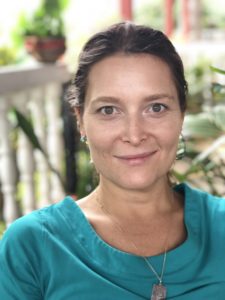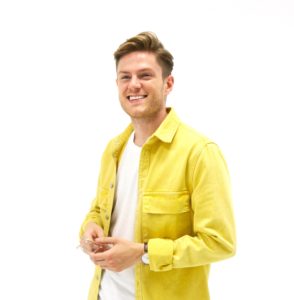Curationist in Conversation: GARRETT GRADDY-LOVELACE & BRANDON ROY
Meet two more contributors who help make Curationist a reality:


What brought you to Curationist? What is your engagement with it?
Garrett Graddy-Lovelace – The Curationist Operations Director, Taylor Tricarico who is a lifelong friend, invited me in 2016 to join the board of MHz Foundation. At the time, I was pregnant and was on the tenure track, as I’m an academic and felt I didn’t have time. However, she eventually convinced me and I joined the board. I learned so much and it was a great experience to come up with the name and the premise for Curationist collectively, as a board. Then about this time last year I got to thinking Curationist could be used in various coursework and it could be used in terms of research. So, I decided to leave the board and be a consultant, to make the connections of Curationist and academia education at large. I am now the Advisor for Academic and Educational Partnerships.
Brandon Roy – I came on a little bit later than Garrett did! I’m the Marketing and Promotion Specialist for Curationist. I’ve always been drawn to creative projects, so this is something that is really aligned with my personal interests. When I was asked to come on by the team, I was really excited; I’ve always been interested in arts and culture. Coming from a business school background with a specialization in marketing, this felt like an opportune time to combine my academic training with my personal interests; so, combining both marketing and something very creative in the arts and culture space. My mission with my role is to help people, who are also interested in arts and culture, connect with the Curationist platform in a meaningful way. To me, this means participating in its development and really looking through the depths of the internet to find those people who share in our values of open knowledge.
Would you say there’s a difference between “just Googling” something to find an answer and truly understanding a topic?
GG – I was trained in a sector in academia that has historically been wary of the Google search bar and Wikipedia, as shortcuts to knowledge that students use as a crutch. I have since developed more respect for Wikipedia, and I think it’s shifted into a platform where there’s a lot more perspectives coming in to build those definitions and pages and entries. But absolutely, I would say knowledge, real knowledge, is multifaceted. It is dialogic, it is contextual, it is contested, it is complex and it is experiential. Real learning happens in communication, asking questions, exploring something, trying something out. Just plugging something in and getting a response, and assuming that’s the answer, is problematic in terms of cultural knowledge. I would say Curationist can be a curricular tool, and as part of an online learning resource, it’s the context, the dialogue, and the multiple perspectives that is its added value, and will be its added value.
BR – I think you hit the nail on the head. For me, Google searches are fantastic for getting quick access to the information that you need, the bare bones of a topic, but going deeper takes more time. We’re in a culture where we’re often in scarcity mode, and as we say, we don’t have enough time. We’re going to go for those quick fixes of information, and like Garrett said, assume them to be true. But the reality is that in the process, the depths of information and these meaningful stories that contribute to the complexity of all of this knowledge around cultural topics that exist, it’s getting weeded out by us going after the quick information. I think there’s an exciting need that we’re filling in the world. It’s about gathering these like-minded people who are passionate about deeper understanding, and then looking to the other audiences that may be more likely to get quick fixes of information and saying, look at this, you can understand something that you care about on a more meaningful level, and you can talk with people in the world about it. That’s what I’m really excited about when it comes to the potential of Curationist and what it can become.
When was a time when someone’s introduction to a subject or unique perspective made you more interested in it?
BR – In conversation, every time that I’m speaking with someone, we all have personal interests and when we’re talking about them, just seeing someone passionate about something that is meaningful to them makes me want to ask questions. I am perpetually curious and want to know more.
GG – I also am perpetually curious, I think we are alike in that way. I research and teach on agriculture and environmental and land use policy and geographies; recently I’ve been reading a lot of indigenous and black agrarian scholarship about how the history of agriculture is seen from a white perspective in the US. For example, Thomas Jefferson is lauded as “the founding father farmer,” but there are these lost histories of the brilliance of black agricultural contributions to our farming systems and seed systems, not to mention the horrors of enslavement at large. The need to remember diverse histories and diverse geographies around seeds and food ways is really important to decolonizing our understanding of food and agriculture. That has been eye opening for me. I have carried a lot of narrow understandings that, frankly, have a lot of racism tied to them. So, that’s something I’ve been very grateful to be learning about.
The Internet is a global phenomenon, and yet much of the content is from a Global North (aka Global Minority) perspective. Why do you think it’s important to include different perspectives?
GG – Academia has its own biases. Its own white, Eurocentric biases, in terms of what a canon is, what the classics are, what the youth need to know, knowledge, curriculum, etc. Galleries and museums also have some Eurocentric biases in terms of cultural appropriation and who gets to talk about other people’s culture and be an expert on their culture. The internet is either going to reproduce those biases in these open GLAM spaces, and in platforms like Curationist, or digitized museum and cultural content; or the internet could be a place to radically diversify those sets of knowledges. The internet both has the potential to re-entrench these white Eurocentric biases, or even patriarchal bias against non-binary, queer, trans brilliance in cultural and arts spheres, or it has the potential to radically open up the knowledges and the expertises online. I feel like there’s a lot riding on the internet right now. Historically, the internet has re-entrenched the English language hegemony. What would be ways to radically expand and diversify the perspectives and the voices online? There are some very good projects working on this and that’s something that Virginia, the Content Curation Director, her team, the Curationist Fellows, and I, have been trying to connect with so as to align Curationist in the networks and communities of people working on this question. But there’s tech disparity issues, there’s language barriers; but I have a lot of optimism. I think that the youth of the world are hungry for diverse perspectives; they see through the biases. There’s a lot of potential to really expand the set of knowledge and perspectives that are available in the GLAM space and in curriculum spaces online.
BR – Why do you think it’s important that there’s multiple perspectives? I’m curious from your perspective.
GG – Firstly, life has multiple perspectives. So it’s not even correct, you know, if you just have one set of perspectives. But also power dynamics; who gets hired to be an expert, it reflects on who’s had power previously. There’s a whole political economy to re-entrenching disparities. It’s important from an equity and efficacy perspective. For example, we need more Nigerian authors online because there’s an enormous number of people who are from Nigeria who are in their 20s right now, so for the internet to reflect the world correctly, it’s going to have to have much more diverse, more African, African Diaspora, more indigenous voices and languages.
BR – For me, I think to the user of a platform like Curationist and thinking how everyone deserves to see themselves reflected on the internet and everyone should feel like they have a space to share their stories and share their unique perspectives on things and feel that is of meaning to the global community of knowledge. The dominant culture can easily overrule the conversation and be the dominant voice; so, I love that there are projects like Curationist and that there’s a lot of people who want to give opportunity to people to share their stories.
We have access to an almost incomprehensible number of cultural works. Do you think there’s still a value to providing context and commentary alongside this content?
GG – So much! I think that’s another value add of Curationist. It’s not just that this piece of art was held by the Met and digitized by the Met and put into Creative Commons or a public domain licensing, and now Curationist is helping give context to it. It’s that Curationist is also aiming to give the context of how the Met acquired that piece, so there’s now more transparency on how collections work. The Curationist platform is currently using standard metadata and taxonomy, but we’re also currently working on expanding this, so as to add another layer of context; it’s the cultural context of where a piece originated, but also the context of how it was collected and curated over time and over space. I think that would be eye opening for a student or user understanding how collections work, and how knowledge and expertise comes into being and how it’s claimed, and how the internet then is another layer of moving and tagging, and circulating information and cultural content. We’re all about data. I mean, data is a bigger industry right now than fossil fuels. But data without context misses a lot. I think there’s a whole other dimension to knowledge, beyond just numbers and data that Curationist has a great opportunity to help develop.
BR – I don’t know why, but my immediate thought went to the fashion industry, so stay with me for a minute. Historically, how fashion has worked is that you have this group of people who decide what’s going to be the next thing, what’s going to be the next color, the next trend. And that was centered around this small, specific group. Over the past few decades however, I would say it has been almost reversed into a bottom-up structure that allows fashion to present styles that are reflective and meaningful to the diversity of global communities. I imagine this knocking on the doors of the big people in the corporate offices saying, ‘take a look at this, look what’s happening on the street.’ I feel that there’s a similar kind of movement that Curationist is trying to tap into where the people get to speak, and they get to say what’s important to them, where they get to share and own a story from the culture that they exist within, but that we just haven’t been able to tap into that because of what’s been presented to us in our lifetimes and because of whose culture has dominated our history textbooks and discourse online. So I think there’s something very interesting happening right now, and if we can create a platform that creates interesting dialogue around culture and opportunities for individuals and communities around the world to contribute to the site in a positive way, not only can we create an enriching cultural experience, but build a legacy and internet space that we can all be very proud of.
Curationist is one website with multiple views.